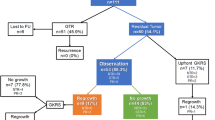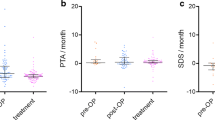Abstract
Purposes
The first aim is to describe the epidemiological, clinical, and radiological characteristics of regressive vestibular schwannomas (VS), based on volumetric measurements on MRI to define which regressions are significant. The secondary aim is to look for a correlation between a shrinkage of the tumor and the medical history, and the presence of clinical symptoms.
Methods
We first selected all patients presenting with a VS who underwent two or more MRI of the internal auditory canal on the same 3 T MRI machine retrospectively between January 2013 and June 2018. All MRI images were evaluated independently by two radiologists. The volumetric analysis was performed contrast-enhanced 2D spin-echo T1-weighted sequence and expressed in cubic centimeters.
Results
Thirty-five patients presented with a regressive VS on MRI (14%). The annual mean shrinkage rate was 0.08 cm3/year. Eighty percent of the patients present both a shrinkage by more than 0.01 cm3/year and a decrease of the initial tumor volume by more than 20%. The majority of patients are asymptomatic or presented moderate balance disorders, which remained stable or improved over time. Tinnitus was observed in 47% and was stable or improved in the majority of cases and the mean annual mean hearing loss was by < or = 4 dB/year.
Conclusion
Out of 247 VS, 14% decreased using follow-up (by > or = 2 MRI), and a spontaneous shrinkage greater than 0.01 cm3/year and greater than 20% could be considered significant.




Similar content being viewed by others
References
Sterkers JM, Perre J, Viala P, Foncin JF (1987) The origin of acoustic neuromas. Acta Otolaryngol (Stockh) 103(5–6):427–431
Stangerup S-E, Tos M, Thomsen J, Caye-Thomasen P (2010) True incidence of vestibular schwannoma?. Neurosurgery 67(5):1335–1340
Yoshimoto Y (2005) Systematic review of the natural history of vestibular schwannoma. J Neurosurg 103(1):59–63
Caye-Thomasen P, Hansen S, Dethloff T, Stangerup S-E, Thomsen J (2006) Sublocalization and volumetric growth pattern of intracanalicular vestibular schwannomas. Laryngoscope 116(7):1131–1135
Huang X, Caye-Thomasen P, Stangerup S-E (2013) Distinct spontaneous shrinkage of a sporadic vestibular schwannoma. Auris Nasus Larynx 40(2):243–246
Huang X, Caye-Thomasen P, Stangerup S-E (2013) Spontaneous tumour shrinkage in 1261 observed patients with sporadic vestibular schwannoma. J Laryngol Otol 127(8):739–743
Hentschel M, Rovers M, Markodimitraki L, Steens S, Kunst H (2019) An international comparison of diagnostic and management strategies for vestibular schwannoma. Eur Arch Otorhinolaryngol 276(1):71–78
Li D, Tsimpas A, Germanwala AV (2015) Analysis of vestibular schwannoma size: a literature review on consistency with measurement techniques. Clin Neurol Neurosurg 138:72–77
Van de Langenberg R, de Bondt BJ, Nelemans PJ, Baumert BG, Stokroos RJ (2009) Follow-up assessment of vestibular schwannomas: volume quantification versus two-dimensional measurements. Neuroradiology 51(8):517–524
Walz PC, Bush ML, Robinett Z, Kirsch CFE, Welling DB (2012) Three-dimensional segmented volumetric analysis of sporadic vestibular schwannomas: comparison of segmented and linear measurements. Otolaryngol Head Neck Surg 147(4):737–743
Varughese JK, Breivik CN, Wentzel-Larsen T, Lund-Johansen M (2012) Growth of untreated vestibular schwannoma: a prospective study. J Neurosurg 116(4):706–712
Lawson McLean AC, McLean AL, Rosahl SK (2016) Evaluating vestibular schwannoma size and volume on magnetic resonance imaging: an inter- and intra-rater agreement study. Clin Neurol Neurosurg 145:68–73
Wu H, Zhang L, Han D et al (2016) Summary and consensus in 7th International Conference on acoustic neuroma: an update for the management of sporadic acoustic neuromas. World J Otorhinolaryngol Head Neck Surg. 2(4):234–239
International bureau for Audiophonology. Biap recommandations 02/1 bis, 1997. https://www.biap.org/fr/recommandations/recommandations/ct-02-classification-des-deficiences-auditives/149-rec-02-01-fr-classification-audiometrique-des-deficiences-auditives/file
Stangerup S-E, Caye-Thomasen P, Tos M, Thomsen J (2006) The natural history of vestibular schwannoma. Otol Neurotol 27(4):547–552
Hoistad DL, Melnik G, Mamikoglu B, Battista R, O’Connor CA, Wiet RJ (2001) Update on conservative management of acoustic neuroma. Otol Neurotol 22(5):682–685
Al Sanosi A, Fagan PA, Biggs NDW (2006) Conservative management of acoustic neuroma. Skull Base 16(2):95–100
Hajioff D, Raut VV, Walsh RM et al (2008) Conservative management of vestibular schwannomas: third review of a 10-year prospective study. Clin Otolaryngol 33(3):255–259
Lees KA, Tombers NM, Link MJ et al (2018) Natural history of sporadic vestibular schwannoma: a volumetric study of tumor growth. Otolaryngol-Head Neck Surg 159(3):535–542
Arribas L, Chust ML, Menéndez A et al (2015) Non surgical treatment of vestibular schwannoma. Acta Otorrinolaringol Esp 66(4):185–191
Bozorg Grayeli A, Refass A, Smail M et al (2008) Diagnostic value of auditory brainstem responses in cerebellopontine angle tumours. Acta Otolaryngol (Stockh) 128(10):1096–1100
Stangerup S-E, Caye-Thomasen P, Tos M, Thomsen J (2008) Change in hearing during “wait and scan” management of patients with vestibular schwannoma. J Laryngol Otol 122(7):673–681
MacKeith S, Wasson J, Baker C et al (2018) Aspirin does not prevent growth of vestibular schwannomas: a case-control study. Laryngoscope 128(9):2139–2144
Marinelli JP, Lees KA, Tombers NM, Lohse CM, Carlson ML (2019) Impact of aspirin and other NSAID use on volumetric and linear growth in vestibular schwannoma. Otolaryngol-Head Neck Surg 160(6):1081–1086
Andler R, Richard J-B, Guignard R et al (2019) Reduction of daily smoking rate among adults: results from the 2018 santé publique france health barometer. Bull Epidémiol Hebd. 15:271–277
Palmisano S, Schwartzbaum J, Prochazka M et al (2012) Role of tobacco use in the etiology of acoustic neuroma. Am J Epidemiol 175(12):1243–1251
Andler R, Richard J-B, Palle C, Spilka S, Quatremère G, Nguyen-Thanh V (2019) Alcohol consumption in France in 2017. Rev Prat 69(8):886–891
Luetje CM (2000) Spontaneous involution of acoustic tumors. Am J Otol 21(3):393–398
Author information
Authors and Affiliations
Corresponding author
Ethics declarations
Ethical approval
This study was approved by the Strasbourg University Hospital Ethics Committee (approval number RNI 2019–HUS N°7417 and NCT number: NCT03970681) and patients gave their written consent for the participation in this study.
Additional information
Publisher's Note
Springer Nature remains neutral with regard to jurisdictional claims in published maps and institutional affiliations.
Rights and permissions
About this article
Cite this article
Trau, G., Venkatasamy, A. & Charpiot, A. Vestibular schwannomas with spontaneous shrinkage: about 35 cases. Eur Arch Otorhinolaryngol 278, 4235–4241 (2021). https://doi.org/10.1007/s00405-020-06530-6
Received:
Accepted:
Published:
Issue Date:
DOI: https://doi.org/10.1007/s00405-020-06530-6




